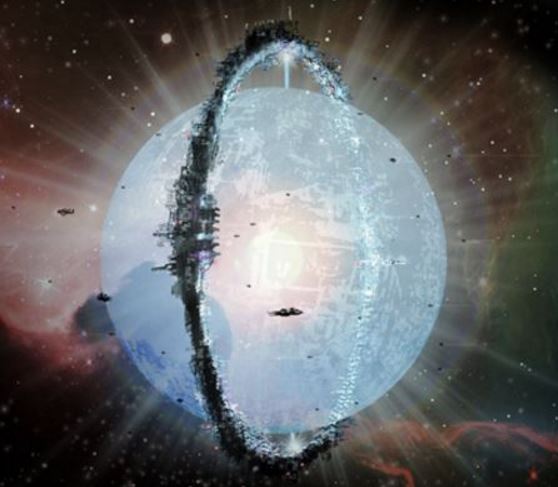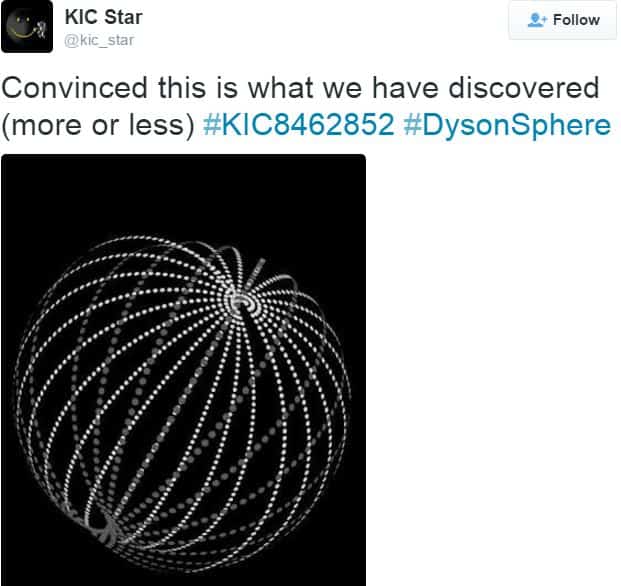An alien megastructure might exist 1,500 light-years away, after an American astronomer reignited speculation that the mysterious dimming of a star is being caused by something super-advanced extraterrestrials have built. He does not say a megastructure is likely, but has ruled out a scientific hypothesis, thus resurrecting the alien theory.
In November 2015, Jason Wright, an astronomer at Pennsylvania State University suggested that the dimming of star KIC 8462852 could be caused by an astroengineering structure. Astroengineering refers to absolutely massive structures, as big as planets, stars, star systems or even galaxies – created by an extremely advanced civilization.
Some lay people, mostly alien enthusiasts, as well as a small number of scientists, wondered whether a Dyson Swarm surrounding a star might cause it to dim in such a bizarre way as this one. A Dyson Swarm, also called a Dyson Sphere, is a hypothetical megastructure (made by aliens) that completely surrounds a star and captures much of its power output.
 An artist’s impression of a Dyson Swarm (Dyson Sphere) – a megastructure made by a super-advanced civilization that completely surrounds a star and harnesses its power. Prof. Schaefer says there is no way one of these could be built in just 100 years.
An artist’s impression of a Dyson Swarm (Dyson Sphere) – a megastructure made by a super-advanced civilization that completely surrounds a star and harnesses its power. Prof. Schaefer says there is no way one of these could be built in just 100 years.
The term – Dyson Swarm – was named after British-born American theoretical physicist and mathematician Freeman John Dyson (born 1923).
Dyson once said:
“One should expect that, within a few thousand years of its entering the stage of industrial development, any intelligent species should be found occupying an artificial biosphere which completely surrounds its parent star.”
Later that month, a team of scientists wrote in the scientific journal The Astrophysical Journal Letters that the phenomenon was being caused by the destruction of a family of comets and not anything deliberately constructed by smart aliens.
Comet theory ruled out, resurrecting alien megastructure theory
Now Bradley Schaefer, Professor of Physics & Astronomy at Louisiana State University’s Department of Physics & Astronomy, has reignited the alien theory by saying comets cannot explain what is happening.
Prof. Schaefer says in previous studies, scientists had looked at data they had gathered and analyzed from a Harvard University archive of digitally-scanned photographic plates in the sky from the past 100 years to determine whether the star had behaved unusually in the past – they found no unusual activity.
 Many people are convinced it is an alien megastructure, like this person who posted an illustration of a Dyson Sphere on Twitter. (Image: twitter.com/kic_star)
Many people are convinced it is an alien megastructure, like this person who posted an illustration of a Dyson Sphere on Twitter. (Image: twitter.com/kic_star)
Prof. Schaefer decided to have another look at KIC 8462852. He averaged the data in five-year bins, looking out for slow, long-term trends. He found that the star dimmed by approximately 20% between 1890 and 1989. He said the basic effect is small but not obvious.
To confirm the slight dimming, Prof. Schaefer went to Harvard University and looked at the original photographic plates, and inspected each one, carefully looking out for any changes.
He saw the same 100-year long dimming in the manual readings, and calculated that for that to occur 648,000 comets, 200 km wide (each one), would have passed in front of the star – extremely unlikely, he said.
Prof. Schaefer has submitted a paper on his findings to a Cornell University Database – arxiv – a repository of electronic pre-prints.
The New Scientist quoted Prof. Schaefer as saying:
“The comet-family idea was reasonably put forth as the best of the proposals, even while acknowledging that they all were a poor lot. But now we have a refutation of the idea, and indeed, of all published ideas.”
“This presents some trouble for the comet hypothesis. We need more data through continuous monitoring to figure out what is going on.”
Sadly for alien enthusiasts, Prof. Schaefer is not too keen on their theory either, which he says runs wrong with his new observations. He does not believe an alien civilization, regardless of how advanced they might be, could build a structure capable of dimming a star by 20% in just 100 years.
Such a structure, if one existed, should radiate light absorbed from the star as heat, but the infrared signal from KIC 8462852 appears normal, he explained.
Prof. Schaefer said:
“There’s no doubt KIC 8462852 is behaving strangely, so something must be responsible. Either one of our refutations has some hidden loophole, or some theorist needs to come up with some other proposal.”
Citation: “KIC 8462852 Faded at an Average Rate of 0.165+-0.013 Magnitudes Per Century From 1890 To 1989,” Bradley E. Schaefer. Cornell University Library. arXiv:1601.03256. Submitted 13 January, 2016.
Video – Building a Dyson Sphere
Imagine it is 50,000 years in the future and we have run out of room to grow on our home planet. Our best bet might be to build settlements in space so they could capture more of the Sun’s energy.


Comments are closed.